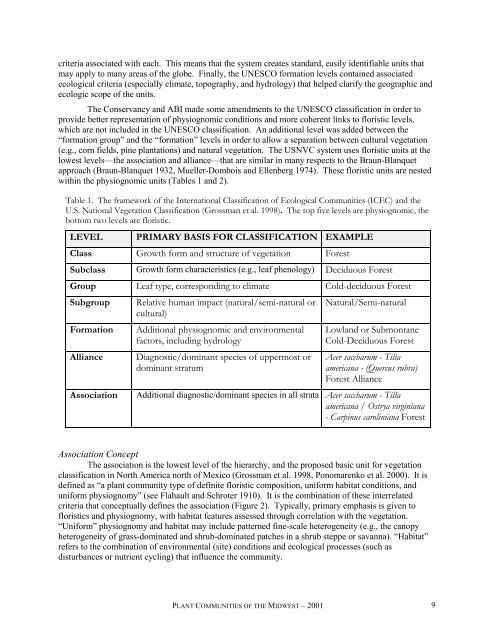Plant Communities of the Midwest - NatureServe
Plant Communities of the Midwest - NatureServe
Plant Communities of the Midwest - NatureServe
You also want an ePaper? Increase the reach of your titles
YUMPU automatically turns print PDFs into web optimized ePapers that Google loves.
criteria associated with each. This means that <strong>the</strong> system creates standard, easily identifiable units that<br />
may apply to many areas <strong>of</strong> <strong>the</strong> globe. Finally, <strong>the</strong> UNESCO formation levels contained associated<br />
ecological criteria (especially climate, topography, and hydrology) that helped clarify <strong>the</strong> geographic and<br />
ecologic scope <strong>of</strong> <strong>the</strong> units.<br />
The Conservancy and ABI made some amendments to <strong>the</strong> UNESCO classification in order to<br />
provide better representation <strong>of</strong> physiognomic conditions and more coherent links to floristic levels,<br />
which are not included in <strong>the</strong> UNESCO classification. An additional level was added between <strong>the</strong><br />
“formation group” and <strong>the</strong> “formation” levels in order to allow a separation between cultural vegetation<br />
(e.g., corn fields, pine plantations) and natural vegetation. The USNVC system uses floristic units at <strong>the</strong><br />
lowest levels—<strong>the</strong> association and alliance—that are similar in many respects to <strong>the</strong> Braun-Blanquet<br />
approach (Braun-Blanquet 1932, Mueller-Dombois and Ellenberg 1974). These floristic units are nested<br />
within <strong>the</strong> physiognomic units (Tables 1 and 2).<br />
Table 1. The framework <strong>of</strong> <strong>the</strong> International Classification <strong>of</strong> Ecological <strong>Communities</strong> (ICEC) and <strong>the</strong><br />
U.S. National Vegetation Classification (Grossman et al. 1998). The top five levels are physiognomic, <strong>the</strong><br />
bottom two levels are floristic.<br />
LEVEL PRIMARY BASIS FOR CLASSIFICATION EXAMPLE<br />
Class Growth form and structure <strong>of</strong> vegetation Forest<br />
Subclass Growth form characteristics (e.g., leaf phenology) Deciduous Forest<br />
Group Leaf type, corresponding to climate Cold-deciduous Forest<br />
Subgroup<br />
Formation<br />
Alliance<br />
Association<br />
Relative human impact (natural/semi-natural or<br />
cultural)<br />
Additional physiognomic and environmental<br />
factors, including hydrology<br />
Diagnostic/dominant species <strong>of</strong> uppermost or<br />
dominant stratum<br />
Natural/Semi-natural<br />
Lowland or Submontane<br />
Cold-Deciduous Forest<br />
Acer saccharum - Tilia<br />
americana - (Quercus rubra)<br />
Forest Alliance<br />
Additional diagnostic/dominant species in all strata Acer saccharum - Tilia<br />
americana / Ostrya virginiana<br />
- Carpinus caroliniana Forest<br />
Association Concept<br />
The association is <strong>the</strong> lowest level <strong>of</strong> <strong>the</strong> hierarchy, and <strong>the</strong> proposed basic unit for vegetation<br />
classification in North America north <strong>of</strong> Mexico (Grossman et al. 1998, Ponomarenko et al. 2000). It is<br />
defined as “a plant community type <strong>of</strong> definite floristic composition, uniform habitat conditions, and<br />
uniform physiognomy” (see Flahault and Schroter 1910). It is <strong>the</strong> combination <strong>of</strong> <strong>the</strong>se interrelated<br />
criteria that conceptually defines <strong>the</strong> association (Figure 2). Typically, primary emphasis is given to<br />
floristics and physiognomy, with habitat features assessed through correlation with <strong>the</strong> vegetation.<br />
“Uniform” physiognomy and habitat may include patterned fine-scale heterogeneity (e.g., <strong>the</strong> canopy<br />
heterogeneity <strong>of</strong> grass-dominated and shrub-dominated patches in a shrub steppe or savanna). “Habitat”<br />
refers to <strong>the</strong> combination <strong>of</strong> environmental (site) conditions and ecological processes (such as<br />
disturbances or nutrient cycling) that influence <strong>the</strong> community.<br />
PLANT COMMUNITIES OF THE MIDWEST – 2001<br />
9
















